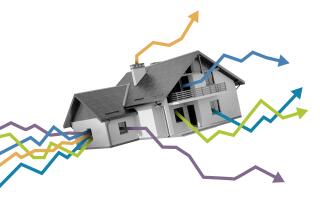Real Estate Group Doubts Recovery
- Share via
SAN DIEGO — Surveying the wreckage of the San Diego County commercial real estate market, it’s hard these days for even brokers, an inherently optimistic lot, to be cheery.
And sure enough, the 1991 market retrospective and 1992 forecast released Wednesday by CB Commercial Real Estate Group’s San Diego office was a dour affair, replete with details that anyone in the real estate development, finance or brokerage business would describe as excruciating.
In 1991, CB Commercial said, office, warehouse and retail rents and property values fell, vacancy rates rose and construction ground to a virtual halt. The forecast? With the continuing recession and severe overbuilding, the likelihood of a short-term recovery is remote.
Prospective tenants aren’t singing the blues, however. The few that exist and are out shopping for leased office, retail and industrial space are striking the deals of a lifetime.
But anyone whose livelihood involves commercial real estate development has rarely, if ever, seen worse conditions. The dollar volume of commercial real estate sale transactions, for example, fell 55% last year. “A lot of brokers are going to be looking at new careers this year,” said CB Commercial’s Andy LaDow, an office leasing specialist.
How deep is the hole in which the local commercial real estate industry finds itself?
* The net total of office space leased last year was only 380,000 square feet countywide, down from a net 1.5 million square feet leased the previous year, LaDow said.
The low net total, which is gross office space rented minus the space “dumped” back on the market by existing tenants, is the lowest in at least a decade and bespeaks not just anemic demand but the shrinkage in local law and accounting firms, financial institutions and other traditional office tenants.
* Only 1,880 apartment-unit construction permits were issued in the county last year, a 71% drop from the previous year. Yet apartment vacancies still hover at 6.2% of all existing units.
The slowdown in apartment construction, however, combined with growing population and San Diego’s increasingly unaffordable home prices, are creating a supply-demand imbalance that will inevitably result in higher rents and apartment values soon, CB Commercial’s Pat Kane said.
* Office buildings in the county and across the nation generally can be acquired at prices that amount to less than their “replacement,” or construction, cost. Values of office properties have plummeted 15% to 30% in the past year. Buyers awash with cash can get even deeper discounts, CB Commercial’s investment specialist Stan Tomer said.
Vacancy rates are “in the mid-20s,” percentage-wise, in several of the county’s sub-markets, LaDow said, near all-time highs.
* Demand for undeveloped commercial land is virtually nil despite price cutting of as much as 35% in locations as prestigious as the Carlsbad Research Center, said Doug Simpson, a CB Commercial broker who focuses on land sales. And land prices will fall even more in 1992, he predicted.
Demand for raw industrial land in Otay Mesa, once thought to be the area’s next boom district, is particularly low, said Brett White, a CB Commercial investment specialist. “It will be years before we absorb (the available buildings) that are already down there,” he said.
* Permanent commercial mortgages to pay off a short-term construction loan are hard to come by and often insufficient. That’s because borrowers now need to come up with twice as much equity as three years ago at the same time that values of most real estate properties are dropping.
* Although new construction has all but stopped, the vacancy rate of industrial space in the county is 11%, up from 10.5% a year ago. The market has been softened by the “dumping” of 750,000 square feet of space by tenants such as General Dynamics and Cipher Data Products, said Rick Sparks, an industrial space broker with CB Commercial.
* Real estate developers bemoan the lack of financing available to build or buy properties, but lenders’ tightfisted approach is understandable in light of the high rate of loan delinquencies. Brian Stoffers of CB Commercial’s mortgage banking unit said 7% of all office loans are either in delinquency or foreclosures.
The plight of lenders is tougher than that statistic indicates. Many lenders have opted to extend or relax terms on developer loans rather than go the foreclosure route. To illustrate, Stoffers said that less than 30% of the office loans that came due in 1991 were paid off.
More to Read
Inside the business of entertainment
The Wide Shot brings you news, analysis and insights on everything from streaming wars to production — and what it all means for the future.
You may occasionally receive promotional content from the Los Angeles Times.









